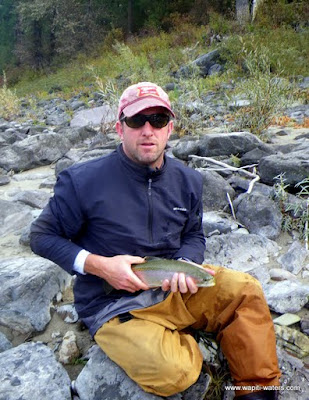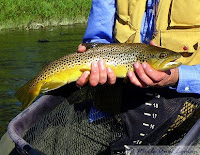
Jack Mauer on Rio Chimehuin (Photo by Merle Ann Loman)
Fly fishing in Montana might be similar to fly fishing in Argentina, but Argentina’s open spaces are even vaster. Jack Mauer first visited the Patagonia region of Argentina in February and March of 2006. He knew that there would be great fly fishing and made the most of it by floating, fly fishing and camping on many different rivers. In 2008, he and his partner, Merle, visited in February and March again. On this trip they spent time in Buenos Aires, San Carlos de Bariloche and San Martín de los Andes. They also fished three rivers, the Chimehuin, Malleo and Collón Curá in the Neuquén District of Argentina. On Jack’s first trip, he fished all these and the Limay, Aluminé and Caleufu rivers.
- See Argentina slideshow here
- Additional photos of Argentina on Merle's SmugMug site in higher resolution
- More fly fishing and Montana river articles
A favorite city to enter the country is the capitol, Buenos Aires. Take the time to explore the city. It is a vibrant and friendly city with outstanding restaurants, shops, museums and architecture. Taxis, buses and walking are great ways to get from district to district.

Church in Buenos Aires (Photo by Merle Ann Loman)
The domestic airport in Buenos Aires is the Jorge Newbery Airport. From there, they flew an Argentinean airline, LAN, to a beautiful town at the base of the Andes called San Carlos de Bariloche. The busy city is on the shores of Lake Nahuel Huapi, which combined with mountains and forests makes a picture book site and offers much for an outdoor enthusiast to do in both summer and winter. Cerro Catedral, one of Argentinas largest ski areas, is just minutes from town. To the north, by way of a beautiful drive through forests and by lakes, are San Martín and Junín de los Andes.
San Martín is on the shores of Lake Lacar. It has a busy bus station. Public buses are a popular way to travel in Argentina. The downtown area and central park are just a few blocks from the lake. The shops are colorful and bustling with activity and goods.
Junín is a bit smaller and is on the banks of the river Chimehuin. It has motels, restaurants, grocery stores and shops surrounding its central park.

Rio Collón Curá (Photo by Merle Ann Loman)
Based out of San Martín, Jack and Merle fished the Chimehuin and Collón Curá, floating and camping for three days. They also spent a day wade fishing the Malleo. For lots of photos of the above mentioned towns and rivers see Merle’s SmugMug photo site, Argentina photos.
Traveling in Argentina is easy and safe as long as you use common sense and keep your valuable belongings with you or safely locked in your lodging. It is useful to visit travel blogs, such as Trip Advisor to see what other people have experienced. The airlines, buses, taxis and rental car companies give you many options for getting around. The infrastructure is modern and well maintained. People in Argentina are very friendly and helpful, many of them speaking English fairly well.
If you want to fish, as in Montana, you need a fishing license. The cost was around $50 at fly shops. Jack recommends using a professional fly fishing guide. Be sure to visit a reputable fly shop for your license and guide. There are rogue guides that are not licensed properly and you do not want to get in trouble with the law by using an unlicensed guide off the street. There are many shops and lodges that hire qualified guides that have a picture ID with proof of license and insurance. The cost of a day fishing float compares to Montana starting at about $400 and going up from there. The best months to fish are November through March.
- Welcome to Argentina – all about Buenos Aires
- Wapiti Waters Fly Fishing Montana – About Jack Mauer
- Montana Fly Fishing blog – posts about Argentina
- National Parks in Patagonia
- Merle’s SmugMug photo site – More Argentina scenic and fly fishing photos in their original format
If you like this article, be the first to see the more, subscribe by email at Merle's Outdoor Recreation site on Examiner.com. You can also subscribe by RSS, Twitter, or Facebook. More Argentina and fly fishing articles coming soon!











